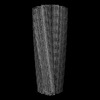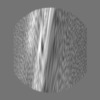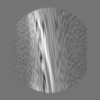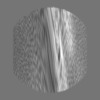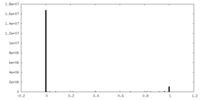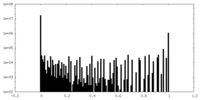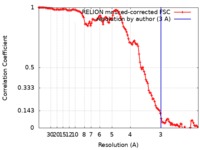[English] 日本語
 Yorodumi
Yorodumi- EMDB-10514: Cryo-EM reconstruction of TypeII tau filaments extracted from the... -
+ Open data
Open data
- Basic information
Basic information
| Entry | Database: EMDB / ID: EMD-10514 | |||||||||
|---|---|---|---|---|---|---|---|---|---|---|
| Title | Cryo-EM reconstruction of TypeII tau filaments extracted from the brains of individuals with Corticobasal degeneration | |||||||||
 Map data Map data | Cryo-EM structure of TypeII tau filaments extracted from the brains of individuals with Corticobasal degeneration | |||||||||
 Sample Sample |
| |||||||||
 Keywords Keywords | tau protein / filament / cross-beta structure / PROTEIN FIBRIL | |||||||||
| Function / homology |  Function and homology information Function and homology informationplus-end-directed organelle transport along microtubule / histone-dependent DNA binding / negative regulation of establishment of protein localization to mitochondrion / neurofibrillary tangle / microtubule lateral binding / axonal transport / positive regulation of protein localization to synapse / main axon / phosphatidylinositol bisphosphate binding / regulation of long-term synaptic depression ...plus-end-directed organelle transport along microtubule / histone-dependent DNA binding / negative regulation of establishment of protein localization to mitochondrion / neurofibrillary tangle / microtubule lateral binding / axonal transport / positive regulation of protein localization to synapse / main axon / phosphatidylinositol bisphosphate binding / regulation of long-term synaptic depression / tubulin complex / negative regulation of tubulin deacetylation / generation of neurons / regulation of chromosome organization / rRNA metabolic process / axonal transport of mitochondrion / regulation of mitochondrial fission / axon development / central nervous system neuron development / intracellular distribution of mitochondria / regulation of microtubule polymerization / microtubule polymerization / lipoprotein particle binding / minor groove of adenine-thymine-rich DNA binding / dynactin binding / negative regulation of mitochondrial membrane potential / apolipoprotein binding / glial cell projection / axolemma / protein polymerization / negative regulation of mitochondrial fission / Caspase-mediated cleavage of cytoskeletal proteins / regulation of microtubule polymerization or depolymerization / positive regulation of axon extension / neurofibrillary tangle assembly / Activation of AMPK downstream of NMDARs / synapse assembly / regulation of cellular response to heat / supramolecular fiber organization / positive regulation of protein localization / regulation of calcium-mediated signaling / somatodendritic compartment / cellular response to brain-derived neurotrophic factor stimulus / cytoplasmic microtubule organization / axon cytoplasm / positive regulation of microtubule polymerization / stress granule assembly / phosphatidylinositol binding / regulation of microtubule cytoskeleton organization / nuclear periphery / protein phosphatase 2A binding / positive regulation of superoxide anion generation / cellular response to reactive oxygen species / astrocyte activation / Hsp90 protein binding / microglial cell activation / cellular response to nerve growth factor stimulus / synapse organization / response to lead ion / PKR-mediated signaling / regulation of synaptic plasticity / protein homooligomerization / SH3 domain binding / regulation of autophagy / memory / microtubule cytoskeleton organization / cytoplasmic ribonucleoprotein granule / neuron projection development / cell-cell signaling / single-stranded DNA binding / microtubule cytoskeleton / protein-folding chaperone binding / actin binding / cellular response to heat / cell body / growth cone / double-stranded DNA binding / microtubule binding / protein-macromolecule adaptor activity / dendritic spine / sequence-specific DNA binding / amyloid fibril formation / microtubule / learning or memory / neuron projection / nuclear speck / membrane raft / axon / negative regulation of gene expression / neuronal cell body / dendrite / DNA damage response / protein kinase binding / enzyme binding / mitochondrion / DNA binding / RNA binding / extracellular region / identical protein binding / nucleus Similarity search - Function | |||||||||
| Biological species |  Homo sapiens (human) Homo sapiens (human) | |||||||||
| Method | helical reconstruction / cryo EM / Resolution: 3.0 Å | |||||||||
 Authors Authors | Zhang W / Murzin AG / Falcon B / Shi Y / Goedert M / Scheres SHW | |||||||||
| Funding support |  United Kingdom, 2 items United Kingdom, 2 items
| |||||||||
 Citation Citation |  Journal: Nature / Year: 2020 Journal: Nature / Year: 2020Title: Novel tau filament fold in corticobasal degeneration. Authors: Wenjuan Zhang / Airi Tarutani / Kathy L Newell / Alexey G Murzin / Tomoyasu Matsubara / Benjamin Falcon / Ruben Vidal / Holly J Garringer / Yang Shi / Takeshi Ikeuchi / Shigeo Murayama / ...Authors: Wenjuan Zhang / Airi Tarutani / Kathy L Newell / Alexey G Murzin / Tomoyasu Matsubara / Benjamin Falcon / Ruben Vidal / Holly J Garringer / Yang Shi / Takeshi Ikeuchi / Shigeo Murayama / Bernardino Ghetti / Masato Hasegawa / Michel Goedert / Sjors H W Scheres /    Abstract: Corticobasal degeneration (CBD) is a neurodegenerative tauopathy-a class of disorders in which the tau protein forms insoluble inclusions in the brain-that is characterized by motor and cognitive ...Corticobasal degeneration (CBD) is a neurodegenerative tauopathy-a class of disorders in which the tau protein forms insoluble inclusions in the brain-that is characterized by motor and cognitive disturbances. The H1 haplotype of MAPT (the tau gene) is present in cases of CBD at a higher frequency than in controls, and genome-wide association studies have identified additional risk factors. By histology, astrocytic plaques are diagnostic of CBD; by SDS-PAGE, so too are detergent-insoluble, 37 kDa fragments of tau. Like progressive supranuclear palsy, globular glial tauopathy and argyrophilic grain disease, CBD is characterized by abundant filamentous tau inclusions that are made of isoforms with four microtubule-binding repeats. This distinguishes such '4R' tauopathies from Pick's disease (the filaments of which are made of three-repeat (3R) tau isoforms) and from Alzheimer's disease and chronic traumatic encephalopathy (CTE) (in which both 3R and 4R isoforms are found in the filaments). Here we use cryo-electron microscopy to analyse the structures of tau filaments extracted from the brains of three individuals with CBD. These filaments were identical between cases, but distinct from those seen in Alzheimer's disease, Pick's disease and CTE. The core of a CBD filament comprises residues lysine 274 to glutamate 380 of tau, spanning the last residue of the R1 repeat, the whole of the R2, R3 and R4 repeats, and 12 amino acids after R4. The core adopts a previously unseen four-layered fold, which encloses a large nonproteinaceous density. This density is surrounded by the side chains of lysine residues 290 and 294 from R2 and lysine 370 from the sequence after R4. | |||||||||
| History |
|
- Structure visualization
Structure visualization
| Movie |
 Movie viewer Movie viewer |
|---|---|
| Structure viewer | EM map:  SurfView SurfView Molmil Molmil Jmol/JSmol Jmol/JSmol |
| Supplemental images |
- Downloads & links
Downloads & links
-EMDB archive
| Map data |  emd_10514.map.gz emd_10514.map.gz | 48.9 MB |  EMDB map data format EMDB map data format | |
|---|---|---|---|---|
| Header (meta data) |  emd-10514-v30.xml emd-10514-v30.xml emd-10514.xml emd-10514.xml | 20.5 KB 20.5 KB | Display Display |  EMDB header EMDB header |
| FSC (resolution estimation) |  emd_10514_fsc.xml emd_10514_fsc.xml | 11.7 KB | Display |  FSC data file FSC data file |
| Images |  emd_10514.png emd_10514.png | 69.8 KB | ||
| Masks |  emd_10514_msk_1.map emd_10514_msk_1.map | 137.1 MB |  Mask map Mask map | |
| Filedesc metadata |  emd-10514.cif.gz emd-10514.cif.gz | 7 KB | ||
| Others |  emd_10514_half_map_1.map.gz emd_10514_half_map_1.map.gz emd_10514_half_map_2.map.gz emd_10514_half_map_2.map.gz | 47.6 MB 47.6 MB | ||
| Archive directory |  http://ftp.pdbj.org/pub/emdb/structures/EMD-10514 http://ftp.pdbj.org/pub/emdb/structures/EMD-10514 ftp://ftp.pdbj.org/pub/emdb/structures/EMD-10514 ftp://ftp.pdbj.org/pub/emdb/structures/EMD-10514 | HTTPS FTP |
-Validation report
| Summary document |  emd_10514_validation.pdf.gz emd_10514_validation.pdf.gz | 437 KB | Display |  EMDB validaton report EMDB validaton report |
|---|---|---|---|---|
| Full document |  emd_10514_full_validation.pdf.gz emd_10514_full_validation.pdf.gz | 436.1 KB | Display | |
| Data in XML |  emd_10514_validation.xml.gz emd_10514_validation.xml.gz | 17.5 KB | Display | |
| Arichive directory |  https://ftp.pdbj.org/pub/emdb/validation_reports/EMD-10514 https://ftp.pdbj.org/pub/emdb/validation_reports/EMD-10514 ftp://ftp.pdbj.org/pub/emdb/validation_reports/EMD-10514 ftp://ftp.pdbj.org/pub/emdb/validation_reports/EMD-10514 | HTTPS FTP |
-Related structure data
| Related structure data | 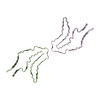 6tjxMC  6tjoC C: citing same article ( M: atomic model generated by this map |
|---|---|
| Similar structure data | |
| EM raw data |  EMPIAR-10340 (Title: Cryo-EM reconstruction of tau filaments extracted from the brains of three individuals with Corticobasal degeneration EMPIAR-10340 (Title: Cryo-EM reconstruction of tau filaments extracted from the brains of three individuals with Corticobasal degenerationData size: 2.8 TB Data #1: Unaligned movies for Case 1 [micrographs - multiframe] Data #2: Unaligned movies for Case 2 [micrographs - multiframe] Data #3: Unaligned movies for Case 3 [micrographs - multiframe]) |
- Links
Links
| EMDB pages |  EMDB (EBI/PDBe) / EMDB (EBI/PDBe) /  EMDataResource EMDataResource |
|---|---|
| Related items in Molecule of the Month |
- Map
Map
| File |  Download / File: emd_10514.map.gz / Format: CCP4 / Size: 137.1 MB / Type: IMAGE STORED AS FLOATING POINT NUMBER (4 BYTES) Download / File: emd_10514.map.gz / Format: CCP4 / Size: 137.1 MB / Type: IMAGE STORED AS FLOATING POINT NUMBER (4 BYTES) | ||||||||||||||||||||||||||||||||||||||||||||||||||||||||||||
|---|---|---|---|---|---|---|---|---|---|---|---|---|---|---|---|---|---|---|---|---|---|---|---|---|---|---|---|---|---|---|---|---|---|---|---|---|---|---|---|---|---|---|---|---|---|---|---|---|---|---|---|---|---|---|---|---|---|---|---|---|---|
| Annotation | Cryo-EM structure of TypeII tau filaments extracted from the brains of individuals with Corticobasal degeneration | ||||||||||||||||||||||||||||||||||||||||||||||||||||||||||||
| Projections & slices | Image control
Images are generated by Spider. | ||||||||||||||||||||||||||||||||||||||||||||||||||||||||||||
| Voxel size | X=Y=Z: 1.15 Å | ||||||||||||||||||||||||||||||||||||||||||||||||||||||||||||
| Density |
| ||||||||||||||||||||||||||||||||||||||||||||||||||||||||||||
| Symmetry | Space group: 1 | ||||||||||||||||||||||||||||||||||||||||||||||||||||||||||||
| Details | EMDB XML:
CCP4 map header:
| ||||||||||||||||||||||||||||||||||||||||||||||||||||||||||||
-Supplemental data
-Mask #1
| File |  emd_10514_msk_1.map emd_10514_msk_1.map | ||||||||||||
|---|---|---|---|---|---|---|---|---|---|---|---|---|---|
| Projections & Slices |
| ||||||||||||
| Density Histograms |
-Half map: Half map1
| File | emd_10514_half_map_1.map | ||||||||||||
|---|---|---|---|---|---|---|---|---|---|---|---|---|---|
| Annotation | Half map1 | ||||||||||||
| Projections & Slices |
| ||||||||||||
| Density Histograms |
-Half map: Half map2
| File | emd_10514_half_map_2.map | ||||||||||||
|---|---|---|---|---|---|---|---|---|---|---|---|---|---|
| Annotation | Half map2 | ||||||||||||
| Projections & Slices |
| ||||||||||||
| Density Histograms |
- Sample components
Sample components
-Entire : Tau filaments extracted from the Frontal cortex of a patient with...
| Entire | Name: Tau filaments extracted from the Frontal cortex of a patient with corticobasal degeneration. |
|---|---|
| Components |
|
-Supramolecule #1: Tau filaments extracted from the Frontal cortex of a patient with...
| Supramolecule | Name: Tau filaments extracted from the Frontal cortex of a patient with corticobasal degeneration. type: complex / ID: 1 / Parent: 0 / Macromolecule list: all Details: Corticobasal degeneration (CBD) is characterised by abundant filamentous tau inclusions that are made of isoforms with four microtubule-binding repeats (4R). |
|---|---|
| Source (natural) | Organism:  Homo sapiens (human) Homo sapiens (human) |
| Molecular weight | Theoretical: 460 KDa |
-Macromolecule #1: Microtubule-associated protein tau
| Macromolecule | Name: Microtubule-associated protein tau / type: protein_or_peptide / ID: 1 / Number of copies: 6 / Enantiomer: LEVO |
|---|---|
| Source (natural) | Organism:  Homo sapiens (human) Homo sapiens (human) |
| Molecular weight | Theoretical: 45.919871 KDa |
| Sequence | String: MAEPRQEFEV MEDHAGTYGL GDRKDQGGYT MHQDQEGDTD AGLKESPLQT PTEDGSEEPG SETSDAKSTP TAEDVTAPLV DEGAPGKQA AAQPHTEIPE GTTAEEAGIG DTPSLEDEAA GHVTQARMVS KSKDGTGSDD KKAKGADGKT KIATPRGAAP P GQKGQANA ...String: MAEPRQEFEV MEDHAGTYGL GDRKDQGGYT MHQDQEGDTD AGLKESPLQT PTEDGSEEPG SETSDAKSTP TAEDVTAPLV DEGAPGKQA AAQPHTEIPE GTTAEEAGIG DTPSLEDEAA GHVTQARMVS KSKDGTGSDD KKAKGADGKT KIATPRGAAP P GQKGQANA TRIPAKTPPA PKTPPSSGEP PKSGDRSGYS SPGSPGTPGS RSRTPSLPTP PTREPKKVAV VRTPPKSPSS AK SRLQTAP VPMPDLKNVK SKIGSTENLK HQPGGGKVQI INKKLDLSNV QSKCGSKDNI KHVPGGGSVQ IVYKPVDLSK VTS KCGSLG NIHHKPGGGQ VEVKSEKLDF KDRVQSKIGS LDNITHVPGG GNKKIETHKL TFRENAKAKT DHGAEIVYKS PVVS GDTSP RHLSNVSSTG SIDMVDSPQL ATLADEVSAS LAKQGL UniProtKB: Microtubule-associated protein tau |
-Experimental details
-Structure determination
| Method | cryo EM |
|---|---|
 Processing Processing | helical reconstruction |
| Aggregation state | filament |
- Sample preparation
Sample preparation
| Concentration | 2.0 mg/mL | |||||||||
|---|---|---|---|---|---|---|---|---|---|---|
| Buffer | pH: 7.4 Component:
Details: 20 mM Tris, pH 7.4, 100mM NaCl | |||||||||
| Vitrification | Cryogen name: ETHANE / Chamber humidity: 100 % / Chamber temperature: 277 K / Instrument: FEI VITROBOT MARK IV / Details: Blot force: -12 ; Blot time: 4s. | |||||||||
| Details | The tau filaments were extracted from the Frontal cortex of a patient with corticobasal degeneration by using sarkosyl and ultracentrifuge. |
- Electron microscopy
Electron microscopy
| Microscope | FEI TITAN KRIOS |
|---|---|
| Specialist optics | Energy filter - Name: GIF Quantum LS / Energy filter - Slit width: 20 eV |
| Image recording | Film or detector model: GATAN K2 SUMMIT (4k x 4k) / Detector mode: COUNTING / Digitization - Dimensions - Width: 3838 pixel / Digitization - Dimensions - Height: 3710 pixel / Digitization - Frames/image: 1-40 / Number grids imaged: 1 / Number real images: 2567 / Average exposure time: 10.0 sec. / Average electron dose: 1.346 e/Å2 Details: Images were collected in movie-mode at 40 frames every 10 seconds |
| Electron beam | Acceleration voltage: 300 kV / Electron source:  FIELD EMISSION GUN FIELD EMISSION GUN |
| Electron optics | C2 aperture diameter: 70.0 µm / Illumination mode: FLOOD BEAM / Imaging mode: BRIGHT FIELD / Cs: 2.7 mm / Nominal defocus max: 2.8000000000000003 µm / Nominal defocus min: 1.7 µm |
| Sample stage | Specimen holder model: FEI TITAN KRIOS AUTOGRID HOLDER / Cooling holder cryogen: NITROGEN |
| Experimental equipment |  Model: Titan Krios / Image courtesy: FEI Company |
+ Image processing
Image processing
-Atomic model buiding 1
| Details | A stack of three consecutive monomers was refined to preserve nearest-neighbour interactions for the middle chain. Because most residues adopted cross strand conformation, hydrogen-bond restraints were imposed to preserve a parallel, in-register hydrogen bonding pattern in earlier stages of Fourier-space refinements. Local symmetry restraints were imposed to keep all beta strand rungs identical. Side-chain clashes were detected using MOLPROBITY, and corrected by iterative cycles of real-space refinement in COOT and Fourier-space refinement in REFMAC and PHENIX. For each refined structure, separate model refinements were performed against a single half-map, and the resulting model was compared to the other half-map to confirm the absence of overfitting. |
|---|---|
| Refinement | Space: RECIPROCAL / Protocol: AB INITIO MODEL / Overall B value: 25.75 / Target criteria: Fourier shell correlation |
| Output model |  PDB-6tjx: |
 Movie
Movie Controller
Controller


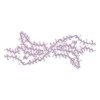

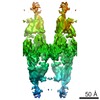




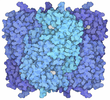
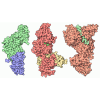
 Z (Sec.)
Z (Sec.) Y (Row.)
Y (Row.) X (Col.)
X (Col.)


